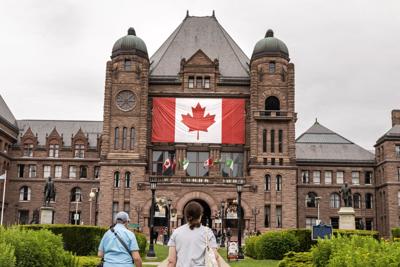Just in time for Canada Day, Canadians have reclaimed their national flag.
The Maple Leaf is misappropriated no more. No longer is our flag being hijacked by a political fringe, converging in convoys on our capital, raging and rampaging against COVID vaccines.
Today, our flag is finally liberated from that virus. The Maple Leaf has been repurposed for patriotism, repositioned as a beacon atop Parliament Hill instead of relegated to pickup trucks blocking the parliamentary precincts.
From far and wide, the flag is front and centre. If not quite centrist, it is no longer languishing on the extreme right to the exclusion of everyone else.
Canada has been back for a while. Now the flag is back — back where it belongs.
With true patriot love. A symbol of unity, solidarity and sovereignty in a time of hegemony and harassment from U.S. President Donald Trump.
It has been 158 years since Confederation brought a new country together — and kept us apart from American expansionism. But it has been only 60 years since a new Maple Leaf flag brought us even closer together, after a quintessentially Canadian quarrel about the detailed design.
Today at Queen’s Park, a giant Maple Leaf flag is draped across the legislative building, signalling Canadian primacy. Last week, near Barrie, a massive Canadian flag was raised, flying 46 metres in the air.
No longer is our national symbol shrouded in confusion, conflated with the old Red Ensign that served as the unofficial flag until 1965.
Back then, as today, an external event triggered Canadian consciousness. When our troops were deployed to Egypt as peacekeepers after the 1956 Sinai crisis, the Egyptians objected to our shoulder patches displaying the Red Ensign with Britain’s Union Jack embedded so prominently (the British having just invaded their country alongside French and Israeli troops).
As foreign affairs minister, Lester B. Pearson won the Nobel Peace Prize for his role in brokering the peace and deploying the peacekeepers in Egypt. But the incident inspired him to shepherd a new national flag to fruition when he became prime minister.
After the Maple Leaf finally took root, years after Pearson transplanted peace to Sinai, Ontario’s then-premier John Robarts opted for his own mischievous counterattack. Backed by his Progressive Conservative majority in the legislature, he proclaimed a new provincial flag would henceforth preserve those British colonial antecedents.
Thus, three months after Canada discarded the Union Jack, Robarts revived it. The old British symbol was grafted into the left corner of a new Ontario flag, with the provincial coat of arms on the right.
Dubbed “the revenge flag,” it never achieved the prominence or permanence of the Maple Leaf. As parochial as it was provincial, the flag was routinely hoisted but rarely heralded at Queen’s Park and other government locales.
Proof, perhaps, that not every flag rises to the occasion at every flag raising.
Today, more than ever, the Maple Leaf flies proudly during Canada’s moment of truth. Not just on Canada Day, but in recent days and months since the country’s raison d’être has come under attack from across the border.
Trump’s incessant musings about making Canada the 51st state have galvanized opposition to annexation. The president’s repeated declarations of economic war, using tariffs to torpedo entire industries, have rallied Canadians around the flag — not just the Maple Leaf emblazoned on the flag, but also the emblem printed on packages and products, galvanizing a robust Buy Canadian movement.
That’s not to say Canadians are of one mind — or heart — in their optimism or pessimism. Ontarians, Maritimers and Newfoundlanders voice the most patriotic pride — more than half of those surveyed — according to a recent public opinion poll by the Angus Reid Institute.
By contrast, Albertans are more likely than anyone else (even Quebecers) to say they are “not proud” to be Canadian — fully 28 per cent, compared to 18 per cent nationwide. Interestingly, Tories across the country are the least likely to declare that Canada offers a good quality of life — barely half of Conservatives say so, compared to more than 80 per cent of those who vote Liberal or NDP (and, notably, supporters of the Bloc Québécois).
Prosperity and unity, like beauty, are clearly in the eye of the beholder.
The only certainty is that the Maple Leaf has become a totem in a titanic struggle against tariffs and hegemony, aggression and subjugation. Canadians are rallying to the flag, which has become emblematic not of extremism but an existential struggle against external threats.
On this Canada Day, with our backs to the wall, the Canadian flag is back.
The true north strong and free, we stand on guard for thee. Vive le Canada libre!
Error! Sorry, there was an error processing your request.
There was a problem with the recaptcha. Please try again.
You may unsubscribe at any time. By signing up, you agree to our and . This site is protected by reCAPTCHA and the Google and apply.
Want more of the latest from us? Sign up for more at our newsletter page.



























To join the conversation set a first and last name in your user profile.
Sign in or register for free to join the Conversation